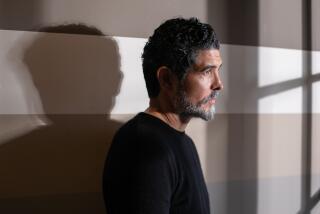‘TIGHT QUARTERS’ : HUNGARIAN FILM SCORES WITH SATIRE
- Share via
Hungarian film maker Gyorgy Szomjas was about as far removed from the world of his satirical comedy “Tight Quarters” as possible.
Here he was, standing in the massive doorway of Mickey Hargitay’s nearly completed hilltop Spanish-baroque castle, ready to discuss a movie that takes place in a seedy two-room Budapest apartment, where a pouty, tempestuous young woman is living calamitously with her recently paroled husband and her current lover.
That Szomjas was in town just as “Tight Quarters” was about to open at the Goldwyn Pavilion was purest coincidence, for he and his cameraman Ferenc Grunwalsky and script consultant Ibolya Fekete were here to prepare a film on Hargitay, one-time Mr. Universe and former husband of Jayne Mansfield.
“I don’t want to talk about this new film too much,” said Szomjas, an affable man of 45 who speaks English with ease. But as the interview progressed it became clear that Szomjas (pronounced soame-yawss ) was fascinated with pop culture and viewed Hargitay, now a successful businessman, as one of its icons, a Hungarian immigrant who pursued the American dream and captured it.
“What interests me is urban folklore, the stories that come from gossip, from the pubs, from graffiti, from the little jokes and the verbal alliterations that are made by the common people,” he said. “ ‘Tight Quarters’ is developed from these things. It’s based on a true story that I read in the newspaper. I found the two actual men and the ex-convict’s mother, who’s very important to the story, but the girl had left the country. I taped them all and also all their neighbors. I got a lot of different versions of what happened among the three--it was the ‘Rashomon’ situation.”
(However, when Szomjas wanted to use these neighbors, they froze before the camera--”only the parolee’s mother is real.”)
“There was lots of improvising. That old lady who recites the naughty poem was real--she just happened by and we used her--and so are the little Gypsy boys who play the song in the street. When we rented the apartment for the film, nobody told the next-door neighbor what we were doing there. Late at night, when we were shooting the party scene, he came in with an ax in his hand. He came between the camera and the actors, but we had no luck: He didn’t raise the ax high enough to get it into the picture.”
Much of “Tight Quarters” is tinted, the colors varying from sequence to sequence, which Szomjas calls an “alienating’ device” intended to heighten the irony of the predicament in which these people find themselves and to underline the role of fate in their lives. He views his use of dialogue and music in the same way, regarding the shifting colors as “perhaps its most spectacular development.”
“It’s half-joking, half-serious. Maybe it’s a revolt against Eastman Kodak.
“We shot 80% of the film in black-and-white, 20% in Eastman Kodak. We made the colors in the lab. We chose them from a whole big list, and we tried them on the Hazeltine, a special machine where you mix the colors on a wide screen, and you can control the result. This is how we ‘painted’ the color.”
However, Szomjas resists giving the colors an emotional code, explaining that the choices were made intuitively.
For the lover in “Tight Quarters,” Szomjas picked the well-established Peter Andorai, best remembered for Istvan Szabo’s “Confidence.” For the beleaguered husband he chose Karoly Eperjes, a wonderfully appealing Gerard Depardieu-type who’s become Hungary’s most popular young star.
For the pivotal role of the young wife, Szomjas cast Mariann Erdos, a non-professional he spotted in a foolish TV documentary about a reform school orphan given a day on the town by the TV people. What appealed to him was how Erdos resisted her interviewer and the TV crew and their cliches--and how much more intelligent she was than they were. (Today she works as a production assistant in the regional theater company run by director Miklos Jancso.)
Shot in 1983 on a brisk 26-day schedule for Hungary’s state-run Mafilm Productions, “Tight Quarters” was made as a result of a fluke.
“We had another project all ready to go when we were told we could not do it--it’s not important now,” said Szomjas, firmly dismissing the subject. “But we had seven pages of ‘Tight Quarters’ to show the man who rejected the other script. He said, ‘Let’s go with it!’ ”
“Tight Quarters” was made for $100,000, half the usual budget, which meant to Szomjas and Fekete more freedom to do what they wanted. (It was the end of the year, and unused money would revert to the Ministry of Culture.)
As a result, “Tight Quarters,” which scored a big success in Hungary, is quite blunt about the frustrations of life in a socialist state. Szomjas admitted he was “a little bit surprised” that he didn’t run into any censorship problems.
“Perhaps they were not irritated because the film is realistic and because of its humor,” he said.
Szomjas describes himself as “a man of the ‘60s,” a period when rock music and the films of Antonioni, of Poland’s Andrzej Vajda--his “Ashes and Diamonds” in particular-- and France’s New Wave were making an impact on young people everywhere. He had studied to be an architect only to realize how little opportunity he would have to practice that profession, and he became one of two dozen people from 1,400 applicants to survive 10 months of examinations to be admitted to the four-year program of Budapest’s Academy of Stage and Film Technique.
For all its sense of immediacy, Szomjas sees “Tight Quarters” as a film of the ‘70s and his newest--and fifth--feature, “The Wall Driller,” as a film of the ‘80s. Like “Tight Quarters,” it is a comedy with social satire, a commentary on Hungary’s new experiments in private enterprise.
“In our suburbs we have these prefabricated concrete housing projects--a terrible environment. . . . The problem is that the walls are very hard, so you have to hire this guy who’s invested in a jackhammer to drill a hole so you can hang a picture!” he said.
More to Read
Only good movies
Get the Indie Focus newsletter, Mark Olsen's weekly guide to the world of cinema.
You may occasionally receive promotional content from the Los Angeles Times.







